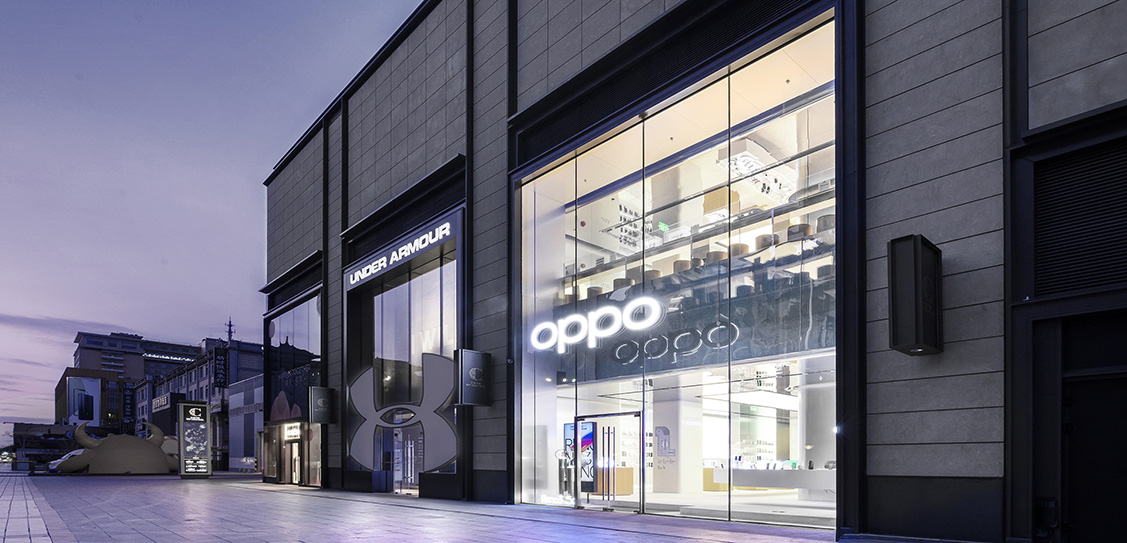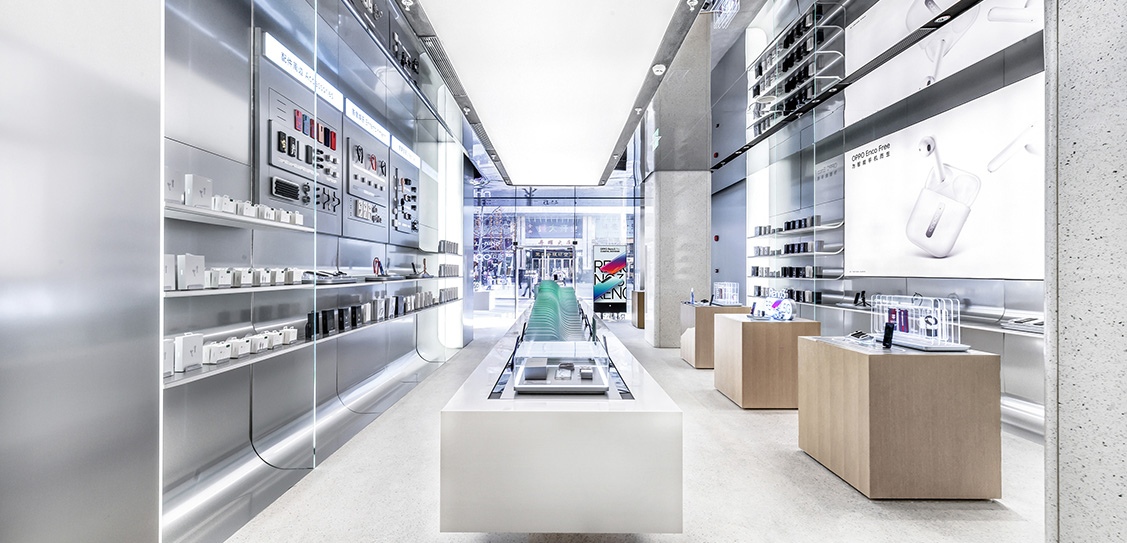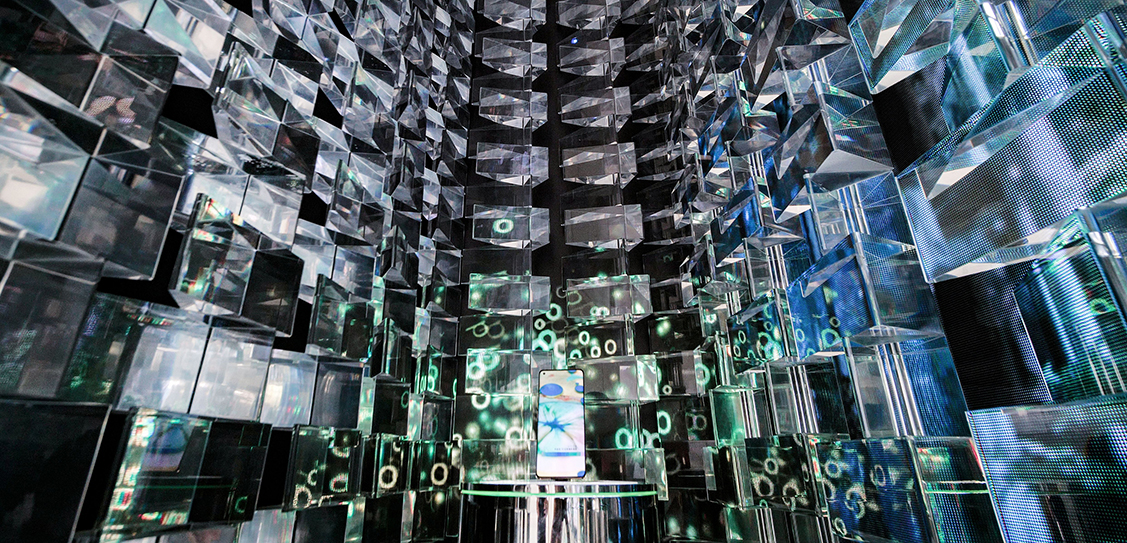The 606 sq m OPPO Guangzhou flagship store, with a 300 sq m facade, is located at Zhengjia Plaza in the Tianhe district of Guangzhou.
It was essential that the design for the store reflects the philosophy of the brand while aligning with the company’s existing design ethos. As such, a total brand experience had to be created for the customers that were highly tailored to OPPO.
The aim was to create a design that would become an integral and recognisable part of the overall branding and a valued experience that customers will want to engage with and return to. With the ambition to create a gathering space that blurs the boundaries between public space and commerce for customers, UNStudio introduced an ‘Urban Park’ concept. This concept creates an inclusive environment that meets the behavioural needs of the various people who visit the store.
The interior is designed as a ‘borderless’ interactive environment, where meandering routes lead visitors through an array of ‘display zones’, thereby creating different rhythms of motion and allowing customers to browse, take their time, pause and try out the products within the store.
The design for the Guangzhou flagship store is approached through a keen focus on craftsmanship, alongside material choices that add a contemporary twist to the vernacular architecture of the city.
Situated along the main thoroughfare, the facade design needed to provide the store with a bold and recognisable visual identity. As a result, a sliced extruded tube component was chosen as the main module and was inspired by bamboo; an important source of food, clothing, housing, and transportation for people in Guangzhou in ancient times.
This metallic tube is also a 3D interpretation of the ‘O’ in OPPO. This dimensional transformation results in a cylindrical tube, into which a cut is added in order to obtain a truncated cylinder. This cylindrical form is repeated in varying lengths and curvatures throughout the facade, creating a reference to both the brand and to technology.
For the overall composition of the facade elements, multiple geometric strategies were studied. Following the exploration of different volumetric options, a large, sweeping folding gesture was chosen which echoes the corner curve of the brand’s logo, while guiding visitors towards the entrance to the store.
Programmable lighting embedded within each tube creates an overall facade effect of dynamism and vibrancy. The result is an optical rhythmic motion across the façade.
Achieving a fluid space in a flowing, uninterrupted movement, where an intuitive sequence of different areas enables customers to experience and interact with the products, was one of the key aims of the interior design.
The interior space is defined by two main experiential zones, Pulse and Evolution. In the Pulse area, the main phone displays act as a strong focal point, while the Evolution areas, in contrast, enable different experiences and accommodate social and interactive zones.
The winding circulation paths weave visitors through these zones, and along with targeted seating that provides comfortable areas for customers to charge their phones, test new products, and socialise.
The store also provides customers with a playful ‘instagrammable’ experience zone, where they are also encouraged to discover the features of the phone’s cameras by taking photos and selfies.
The accentuation of fluid forms with natural wood in a muted palette articulates the interior. Silver anodised aluminium panels juxtapose the rippled translucent glass screens and walls of acrylic prisms. The result is a constant play on the perception of subtly layered changes of depth throughout the interior, and balance between solid and transparent, heavy and light, cold and warm.
White terrazzo embedded with speckles of ‘OPPO green’ create the meandering paths through the store, while integrated ‘pathways’ of lighting in the ceiling mimic this fluid flow and frame the different areas and displays from above. These pathways in the floor and ceiling further serve to guide visitors intuitively along various routes as they wander through and around the space.
UNStudio was invited to carry over the same design DNA to the prominent new Wangfujing Avenue OPPO store in Beijing. The Beijing store has a total area of 428sq m, spread across two floors; this division is made visible to passersby by means of a fully glazed, double-height facade.
In alignment with the Guangzhou flagship, the ambition of the design for the Beijing store was to express ‘Beauty through Technology’. In Beijing, the ‘Urban Park’ remains the driving concept, while a sculptured staircase provides a distinctive feature within the store. This staircase links the two floors of the store in a continuous flow that becomes part of the customer journey.
To counteract the relatively narrow dimensions of the store, and to increase visibility, anodised aluminium panels, glass and mirror panels are used to create reflection and the illusion of depth in the space. To maintain the brand consistency, Terrazzo flooring and the backlit ceiling are carried through from the design of the flagship store in Guangzhou.
On the ground floor, a long, self-supporting, monolithic table serves as a display for the various smart devices, while accessories are displayed along with glass and aluminium shelving that lines the wall.
The staircase serves as a social and experience zone, while the device displays continue on the second level, leading to the repair zone.



